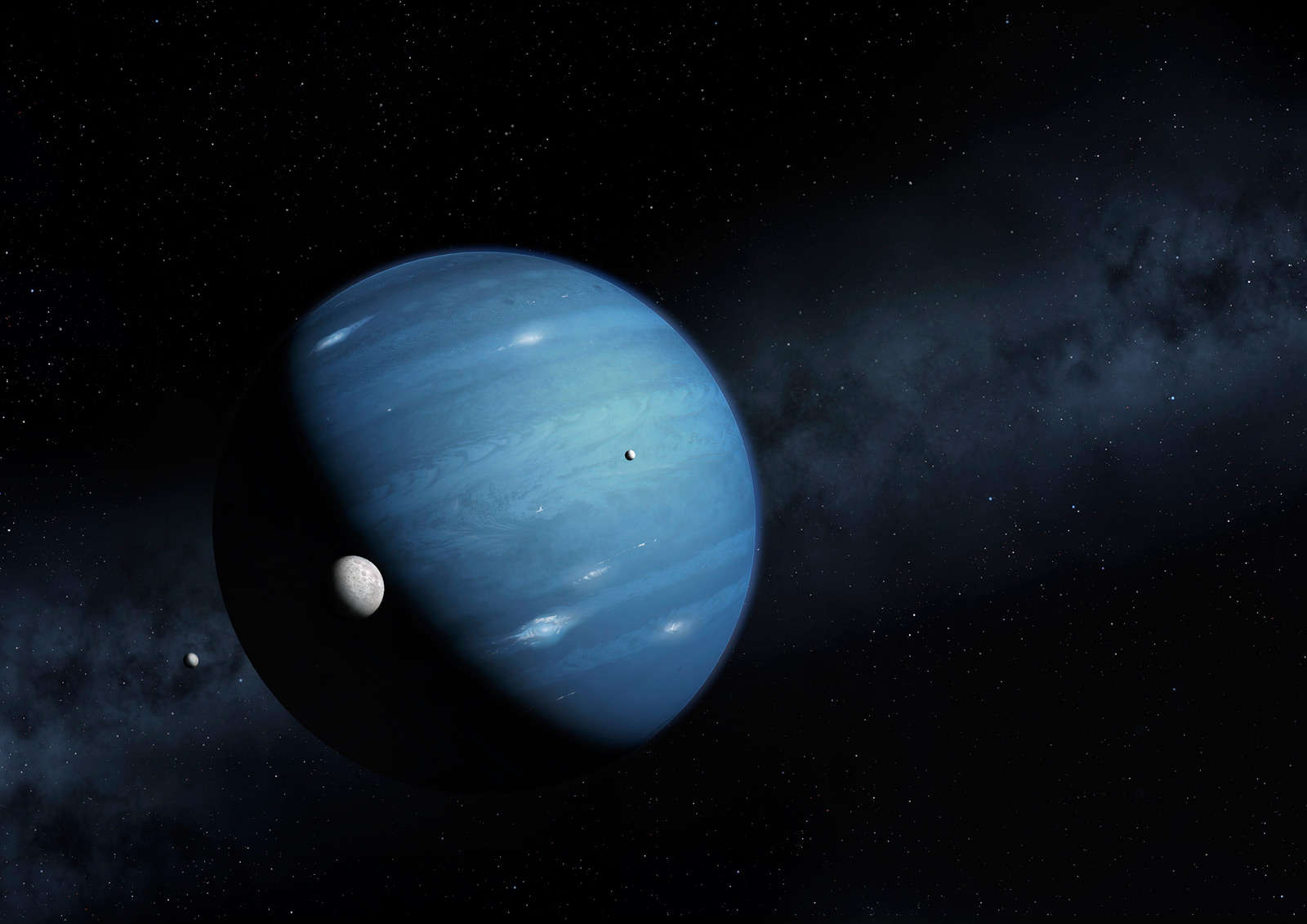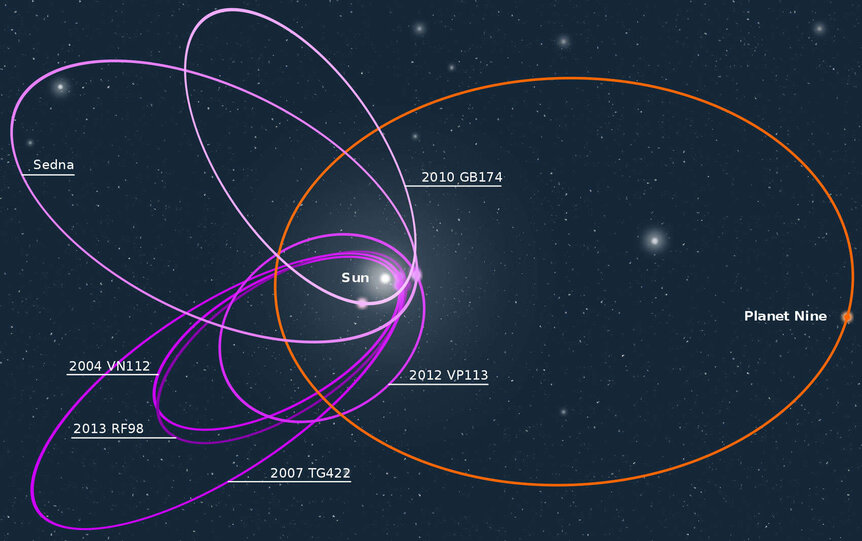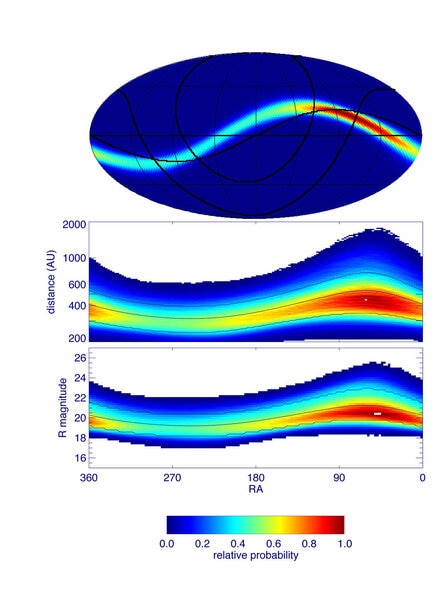Create a free profile to get unlimited access to exclusive videos, sweepstakes, and more!
Want to find Planet Nine? Here's a treasure map.

Do you want to be the first person in 175 years to discover a new planet in our solar system?
Just follow the map.
Well, it’s not all that easy. You’ll need a huge telescope, lots of time, and at least some understanding of what you’re looking for and why. Let me help.
For the past twenty years or so a growing number of astronomers think that there may be another large planet in our solar system well beyond Neptune. Nicknamed Planet Nine*, its existence is inferred from the behavior of a group of icy bodies that orbit the Sun out there as well.
Called Kuiper Belt Objects (or KBOs), they travel on elliptical orbits that can take them hundreds of billions of kilometers from the Sun. You’d expect that the orbits of these objects would be random, tipped and rotated every which way. However, that’s not what’s found: Instead, the long axes of these orbits of known, distant KBOs are oddly aligned, pointing very roughly in the same direction. Also, the orbital planes of these objects are also roughly aligned.
This has been a controversial claim, and many other astronomers have said this may be due to a bias in the way we look for these objects, and others showing that while a bias can exist, it cannot explain the alignments of these objects’ orbits.
The best explanation for this phenomenon is therefore the existence of another planetary body deep in the outer solar system, probably tens of billion of kilometers out. As it orbits the Sun its gravity affects the objects around it, and over time can align their orbits as seen.
OK, great! So, where is it?
In a new paper, astronomers Mike Brown** and Konstantin Batygin have tried to calculate just that. They looked at the shapes of the Kuiper Belt Object orbits and the known biases of observations to try to figure out where Planet Nine is likely to be in the sky. They ran over a hundred physical simulations of tens of thousands of KBOs, allowing their orbits to be affected by Planet Nine for 200 million years. They used different masses for Planet Nine as well as different orbital shapes and orientations for it, then examined the results to see which were consistent with what is actually seen in the sky for the known KBO orbits.
What they found is essentially a map of the probable location of Planet Nine. It’s not an actual map of its location, just where the chances are higher of finding it.
The top map is what’s called a Mollweide projection of the entire sky, mapping it to an ellipse (much like some maps of Earth do). From left to right on the map is east to west on the sky, the north celestial pole is at the top, and the equator runs through the middle. The curved black line is the plane of the solar system (called the ecliptic) and the plane of the Milky Way galaxy is located between the two remaining black lines.
The probability of the location of Planet Nine is represented in color, where blue is very low and red very high — the fuzzy, curved color line essentially traces the likely orbit of the planet projected on the sky, and the blotch of red to the right is the best bet to look for the planet. Not by coincidence, this is the likely location in the sky for the planet’s aphelion — the point in its orbit when it’s farthest from the Sun. Planets move more slowly when they’re more distant for the Sun so they spend more time near aphelion than they do at perihelion, the closest point to the Sun when they are also moving the fastest.
This maps very roughly to the sky near the constellation of Taurus, but again this is just a probable location. It could be anywhere in a broad swath of sky. That does make finding it difficult.
The middle part of the graph shows the probability for the current distance to Planet Nine (measured in Astronomical Units, or AU, a convenient unit for astronomers where 1 AU is the Earth-Sun distance, 150 million kilometers) versus its east/west longitude on the sky (what astronomers, for historical reasons, call Right Ascension, or RA). The highest probability is a distance of 380 AU, or 57 billion kilometers, though there is a wide range of probable distances (about 15 billion km). The bottom map shows how bright the planet may be (in magnitudes, another convenient astronomers’ unit; brighter objects have a lower magnitude). The most probable magnitude is about 20.5, which is faint: The faintest star you can see by eye would be over 600,000 times brighter.
Now, if you’re raring to grab a ‘scope and go look, be warned: Even if Planet Nine is closer and brighter than expected, it’ll take a big observatory to find it, and even then by sweeping the sky for months to look for the slowly moving faint object. If it’s fainter than expected then it could take an 8 to 10-meter class telescope to find it.
There are telescopes like that coming online soon! For example, the Vera Rubin Telescope is an 8.4-meter that will survey the sky, and could very well find Planet Nine.
The brightness of the planet is fairly uncertain; it depends on how big it is and how reflective it is as well. They find the mast likely mass for it is 6.2 times the Earth’s mass (with some uncertainty), but it’s hard to know how big the planet is given that. Its composition is unknown as well. If massive enough it might be a gas giant, but if it’s at the lower end of the mass range it may be a solid ice-and-rock world.
The overall point here is that if they are correct, we now have an idea of where to look. Brown and Batygin have already been searching for it using the Subaru telescope, but the sky is big and Planet Nine — if it exists, mind you — faint, so it may be some time yet before it’s found.
But won’t that be a day? We’re still learning about our solar system, from its inner reaches to its outer limits. There’s space enough to hide an entire planet out there, but, hopefully, not enough to hide it forever.
*It’s difficult if not impossible to define what a planet is, but most astronomers of my acquaintance don’t have a problem with saying Neptune, the eighth planet from the Sun, is the farthest currently known planet.
**In the interest of full disclosure, Mike Brown is a friend of mine. He also sent me the plot and answered some questions I had about this work.

















